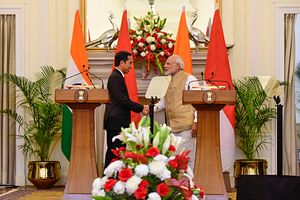Making its “Act East” policy more robust, India has now decided to hold its first-ever joint air combat exercise with Indonesia. And boosting maritime security cooperation, India has additionally offered to train sailors from Indonesia in submarine operations. The two countries also agreed to cooperate in defense manufacturing and to expand military-to-military cooperation.
Indonesian President Joko “Jokowi” Widodo was in India in December last year when the two nations had agreed to “conclude a substantive bilateral Defense Cooperation Agreement” and “explore collaboration between defense industries for joint production of equipment with technology transfer.” Against a backdrop of changing regional balances of power, this growing Delhi-Jakarta relationship assumes significance.
During Jokowi’s visit, the two nations took aim at China’s aggressive stance on South China Sea when they “stressed the importance of resolving disputes by peaceful means, in accordance with universally recognized principles of international law, including UNCLOS.” This is significant as India and Indonesia do not have direct claims in this dispute, but both are concerned about China’s territorial expansionism and its reluctance to abide by global norms. Modi and Jokowi also want their nations to emerge as major maritime powers to ensure a stable maritime order in the region, one that is under stress because of China’s rapid rise and the United States’ growing reluctance to be the sole guarantor of regional security. Where India is worried about the security of the sea lanes of communication in the larger Indo-Pacific, Indonesia has been concerned about Chinese maritime intrusions near the Natuna islands, in waters which it claims as part of its exclusive economic zone, as well as Chinese attempts in the past to include parts of the island chain’s waters in its capacious territorial maps.
India and Indonesia have been gradually enhancing their security and political ties. The two signed a strategic partnership agreement in 2005 that started an annual strategic dialogue. The next year, they ratified a defense cooperation agreement, initially signed in 2001, which focused on areas of defense supplies and technology, as well as on joint projects. The two have signed an extradition treaty and also a “mutual legal assistance treaty” for gathering and exchanging information to enforce their laws. Joint naval exercises, patrols, and regular port calls by their respective navies have become a regular feature of the India-Indonesia relationship in recent years. India has also become a major source of military hardware for Jakarta.
Such cooperation is a natural result of geography. Indonesia’s location, combined with its naval forces, allow it to work effectively with India to ensure security in the sea lanes of communication between Europe, the Middle East, and Southeast Asia. Together, they control the entry point from the Bay of Bengal in the Indian Ocean to the Strait of Malacca. Similarities in democratic governing systems and broad foreign-policy outlooks have helped dramatically: Viewing India’s maritime presence as benign, Indonesia has openly invited India to help littoral states in the region maintain the strait’s security.
New Delhi’s ambitious policy in East and Southeast Asia is aimed at significantly increasing its regional profile. Smaller states in the region are now looking to India to act as a balancer in view of China’s growing influence, while larger states also see it as an attractive engine for regional growth. It remains to be seen if India can indeed live up to its full potential, as well as to the region’s expectations. But with the Modi government’s wooing of regional states, India is signalling that it is indeed serious about its presence in Southeast Asia. As India moves away from its traditional “non-aligned” mentality, recent trends in India-Indonesia partnership are likely to usher in a new era in the bilateral relations between two of the most prominent Indo-Pacific powers.

































